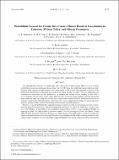Probabilistic Forecast for Twenty-First-Century Climate Based on Uncertainties in Emissions (Without Policy) and Climate Parameters
Author(s)
Jacoby, Henry D.; Wang, Chien; Reilly, Judith M.; Dutkiewicz, Stephanie; Schlosser, Adam; Paltsev, Sergey; Webster, Mort David; Sarofim, M. C.; Prinn, Ronald G.; Forest, Chris E.; Stone, Peter H.; Sokolov, Andrei P.; Melillo, Jerry M.; Felzer, B.; Kicklighter, David; ... Show more Show less
DownloadSokolov-2009-Probabilistic Foreca.pdf (4.314Mb)
PUBLISHER_POLICY
Publisher Policy
Article is made available in accordance with the publisher's policy and may be subject to US copyright law. Please refer to the publisher's site for terms of use.
Terms of use
Metadata
Show full item recordAbstract
The Massachusetts Institute of Technology (MIT) Integrated Global System Model is used to make probabilistic projections of climate change from 1861 to 2100. Since the model’s first projections were published in 2003, substantial improvements have been made to the model, and improved estimates of the probability distributions of uncertain input parameters have become available. The new projections are considerably warmer than the 2003 projections; for example, the median surface warming in 2091–2100 is 5.1°C compared to 2.4°C in the earlier study. Many changes contribute to the stronger warming; among the more important ones are taking into account the cooling in the second half of the twentieth century due to volcanic eruptions for input parameter estimation and a more sophisticated method for projecting gross domestic product (GDP) growth, which eliminated many low-emission scenarios.
However, if recently published data, suggesting stronger twentieth-century ocean warming, are used to determine the input climate parameters, the median projected warming at the end of the twenty-first century is only 4.1°C. Nevertheless, all ensembles of the simulations discussed here produce a much smaller probability of warming less than 2.4°C than implied by the lower bound of the Intergovernmental Panel on Climate Change (IPCC) Fourth Assessment Report (AR4) projected likely range for the A1FI scenario, which has forcing very similar to the median projection in this study. The probability distribution for the surface warming produced by this analysis is more symmetric than the distribution assumed by the IPCC because of a different feedback between the climate and the carbon cycle, resulting from the inclusion in this model of the carbon–nitrogen interaction in the terrestrial ecosystem.
Date issued
2009-10Department
Massachusetts Institute of Technology. Joint Program on the Science & Policy of Global ChangeJournal
Journal of Climate
Publisher
American Meteorological Society
Citation
Sokolov, A. P et al. “Probabilistic Forecast for Twenty-First-Century Climate Based on Uncertainties in Emissions (Without Policy) and Climate Parameters.” Journal of Climate 22.19 (2009): 5175-5204. © 2010 American Meteorological Society
Version: Final published version
ISSN
0894-8755
1520-0442